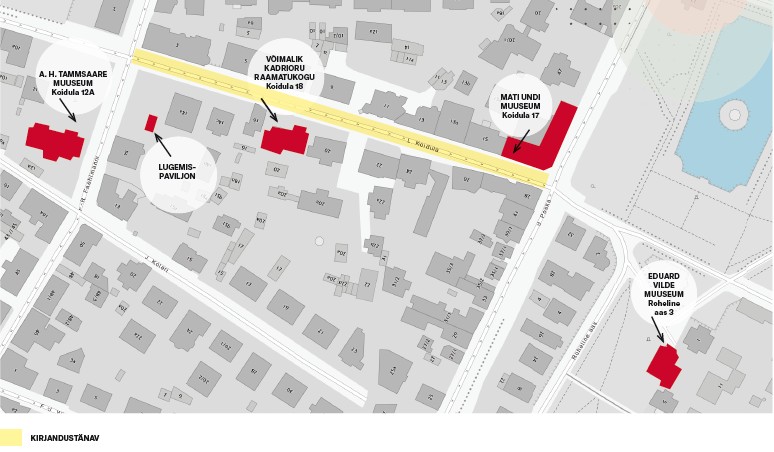Literary Street

Koidula Street in Kadriorg is a particularly connected with literary. Lydia Koidula is a great figure of Estonian poetry, 19th century romantic patriotic singer-songwriter. At the beginning of the street that bears his name is the home of the most important literary classic of our 20th century, A. H. At the other end of the street is the museum of Eduard Vilde, the founder of Estonian realist literature.
In the middle of the street is the museum of our literary innovator of the second half of the 20th century and theatre director Mati Unt. It is located in a house that was built for writers at the end of the 1980s and is still home to several beloved writers, such as Viivi Luik, Jaak Jõerüüt, Mari Saat, Ülo Tuulik and others. We also envision a library in the middle of the street.
2020. , a reading pavilion was opened on the corner of Koidula and Faehlmann streets to give books and literature a more visible presence in the public space of the city. The book saves some people from being lost, said A. H. Tammsaare. The Reading Pavilion is an exceptional phenomenon not only in Kadriorg, but in Estonia as a whole, and there is no similar place popularising literature in neighbouring countries.

2017. The Literary Street Festival, organised by the Tallinn Literary Centre on Koidula Street, aims to draw attention to Estonian literature, literary heritage and the literary public space around us.
To this end, a variety of organisations directly or indirectly involved in literature have been gathered on the street, with whom a rich cultural programme will be created. Over the course of the day, thousands of people visit the festival, with around 60 different events ranging from book launches to unique literary events. In addition to the literary crowd, we will bring together the local community, who will contribute both with courtyard cafés and an involvement in the programme. The festival was nominated in the “Friend of the Community” category at the Estonian Museums Awards. In the light of the above, we believe that the Literary Street, which has already been successfully established and developed, needs to be formalised in the public space with specific and meaningful design elements.
In this way, the uniqueness of Literary Street would be even more visually apparent. The city of Tallinn would get an original cultural object in the form of such a street, which would appreciate and highlight our cultural heritage, contemporary literature and value public urban space. We do not know of a similar literary street elsewhere in Europe, so it could become a tourist attraction.

In this way, the uniqueness of Literary Street would be even more visually apparent. The city of Tallinn would get an original cultural object in the form of such a street, which would appreciate and highlight our cultural heritage, contemporary literature and value public urban space. We do not know of a similar literary street elsewhere in Europe, so it could become a tourist attraction.
A working version of the street reconstruction plan is available HERE.
